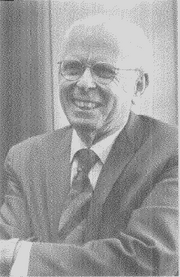C. Hewitt Dix
C. Hewitt Dix (1905-1984) An American mathematician and geophysicist.
Biography for the Citation for the SEG Maurice Ewing Medal 1979 [1][2]
Contributed by Raymond A. Peterson
"A teacher affects eternity. He can never tell where his influence stops." - Henry Adams
To honor the memory of Maurice Ewing and his enormous contributions to geophysics, The Maurice Ewing Medal award was established in 1978, as the highest honor the Society can bestow. In this year 1979, it is particularly fitting and gratifying that Charles Hewitt Dix has been chosen as honoree. He has been a member of SEG since 1935, and over the many succeeding years has continued to make outstanding contributions to the advancement of the science and profession of exploration geophysics. In 1969, the Society elected him an Honorary Member.
It is a propitious circumstance that Maurice Ewing and Hewitt Dix were both graduate students at Rice University in the late 1920s, were close neighbors near the campus, attended some of the same classes, and developed a friendship which extended over the succeeding years.
Charles Hewitt Dix was born in Los Angeles in 1905, attended California Institute of Technology from 1923 to 1927, and received his degree in physics in 1927. In the fall of that year he heeded that memorable advice "Go East, young man!" and drove from Los Angeles to Houston with L. M. Mott-Smith, then instructor in physics, as was Andrew Bryan, at Rice University. During 1927-31 Hewitt pursued graduate studies at Rice, and in 1931 he received his Ph.D. degree in mathematics. One of his classmates was Will Rust, Jr. From 1929 to 1934, he also gained valuable teaching experience as a full time instructor in mathematics at Rice. Afterward, Hewitt served as research geophysicist with Humble Oil and Refining Co. from 1934 to 1937, under Dr. Ludwig Blau and Dave Carlton. He spent two years "trouble shooting" field crew operations in remote areas of Venezuela and Colombia. This intimate contact with day-to-day geophysical operations and field problems made a lasting imprint on Hewitt. He thus developed that valuable ability to maintain a happy balance between the practical and the theoretical. During 1939-41, Hewitt served as research geophysicist for Socony Vacuum Oil Co. and General Petroleum Corp. He then served as chief seismologist and vice-president of United Geophysical Corp. from 1941 to 1947.
In 1948, Dr. Dix returned to his alma mater, CalTech, where for the next 25 years as professor of geophysics he shared with and passed on to students his broad spectrum of knowledge and experience. During this period, he also spent one year as a Fulbright Fellow at the University of Tokyo, and several months lecturing in France and Chile under the sponsorship of the U.S. State Department. In 1973 he retired from CalTech highly honored with the well-deserved title of Professor Emeritus.
Dr. Dix's works and publications have provided a sound base for the study of the fundamentals of exploration geophysics. They are well known and have been widely used by explorationists throughout the world. The number of students and geophysicists who have benefited from his contributions and scholarship are legion. Dr. Dix's first published article appeared in the July 1935 issue of the Journal of the Society of Petroleum Geophysicists. This predated by 6 months the first published issue of Geophysics. Over the years, Dr. Dix published many papers in Geophysics. Particularly well known are those dealing with the detailed determination of seismic wave velocities in rock from seismic reflection data. His 1952 book, Seismic Prospecting for Oil, is still one of the best references for practicing exploration geophysicists. His translation and revision, with Edward A. Flinn, of Cagniard's classic, Reflection and Refraction of Progressive Seismic Waves, is widely known.
Charles Hewitt Dix, please accept The Maurice Ewing Medal as an expression of appreciation, and as a token of the high esteem in which you are held by your fellow members of the SEG!
Seismic Prospecting for Oil (Harper Brothers, 1952)
When this textbook was published, recorded amplitudes were regarded as of little use, since the instrumental amplification was controlled so informally. But Dix wrote (p. 383),"It is this writer's opinion that this particular information [seismic amplitude] is often of considerable value when used in connection with other bits of information in difficult cases." This insight preceded AVO by 30 years.
References
- ↑ Clark, R. (1984) C. Hewitt Dix.” The Leading Edge, 3(8), 14–17.
- ↑ Awards Citations of SEG (1998) SEG Press, Tulsa, Oklahoma
